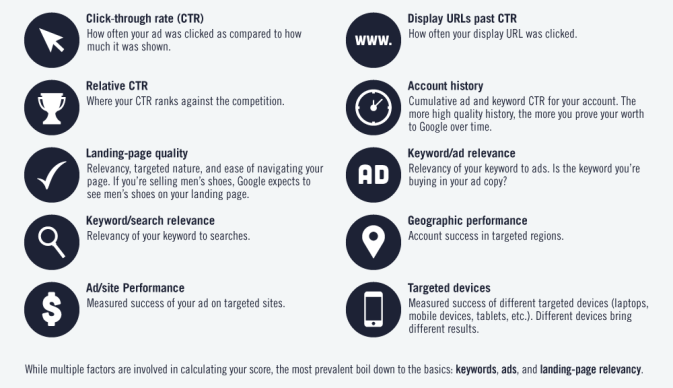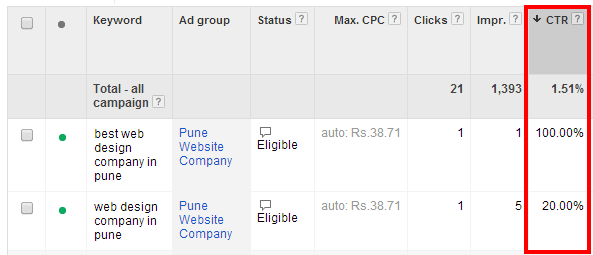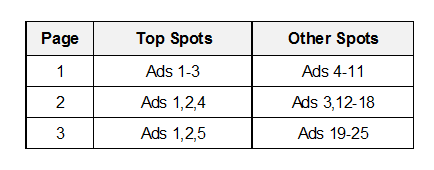You might think that Google simply rewards the highest bidders with the top positions on search results pages. But this is not so.
It’s not that Google doesn’t want money; it’s just that it wants to keep on getting the money. And Google will only continue to earn billions of dollars a year if searchers find relevant adverts and not just wealthy advertisers and companies.
This is what makes Google advertising exciting. With Google adverts even a small company can get relevant traffic and business if they know how to use the system.
Google uses a metric called ‘Ad Rank’ to determine what order to display relevant adverts to searchers. The advert with the highest Ad Rank comes on top.
Ad Rank = Quality Score x Max CPC bid
Ad Rank score is based on your Bid and Quality Score of your ad. So both bidding amount and Quality score are equally important to get higher placements.
If you’re using the cost-per-click bidding option, your bid is how much you’re willing to pay for a single click on your ad. While, Your Quality Score is a measurement of how relevant and useful your keyword, ad text, and landing page are to what a user is searching for.
To improve your ad position, you can increase your bid, or you can focus on improving your Quality Score. Google rewards relevant adverts by displaying them higher on the page and charging less per click.
Quality Score (1-10 rating with 10 being the best) is Google’s calculation of how relevant your advert and landing page are to the keyword being bid for. We’ll look at landing pages is another post but for now you need to know that the biggest influence on your Quality Score is your ads’ clickthrough rate (CTR).
High Clickthrough rate is the key to good quality score:
Clickthrough rate (CTR) is the % of searchers who click (Clicks) your advert when it is displayed (Impressions (Impr.)). Review the following screenshot from Google Adwords:
The biggest influence on your CTR is the relevance of your ad to the keyword. If a user has searched for Digital Marketing in pune and your advert headline says ‘Digital marketing in pune’ then it is highly relevant.
The searcher is much more likely to click on your relevant ad than an irrelevant one that says ‘Advertising in pune’
Relevance increases your clickthrough rate (CTR).
The higher your CTR the higher your Quality Score. The higher your Quality Score, the higher your Ad Rank.
The higher your Ad Rank, the higher you will appear on Google’s search results pages, which will in turn increase CTR.
Best of all, the higher your Quality Score the less you’ll pay per click. Google really does reward for relevant adverts.
How ads cycle through the search result pages
Ads cycle through the search result pages based on their Ad Rank. The ad with the highest Ad Rank appears in the first eligible position on the search results page. The ad with the second-highest Ad Rank appears beneath it, and so on down the page.
When a customer browses to subsequent search result pages (for example – they click Next to see additional pages of search results), the following two rules typically apply for which ads are eligible to show where:
“Top” placement (top of the page):
All high-ranking ads are eligible to show in the top positions, provided they exceed a certain Quality Score and cost-per-click (CPC) bid threshold. Up to three ads can show in the top positions on each page.
“Other” placement (side or bottom of the page):
The side and bottom of a search results page is recorded as “Other” in your AdWords statistics, and can show up to eight ads. Typically, ads that haven’t previously appeared in the side or bottom placements are eligible to appear in the side or bottom. For example, if an ad appeared on the side of Page 1, it typically won’t appear on the side for Page 2 or later.
Ads 1-25 are available to show for a certain search term, and ads 1-7 are eligible for the top spots.
The ads can be ranked on the page like this:
What it tells us that if we have average ad placement up to 5 we have a good chance of showing on the top positions.
Please let us know if you have any questions or comments below.

 +91 7420018003
+91 7420018003


